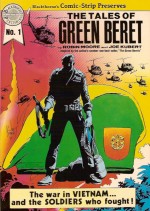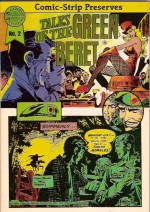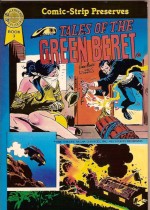


By Robin Moore & Joe Kubert (Blackthorne/Comic Strip Preserves)
ISBNs: 0-932629-36-9, 0-932629-48-2 and 0-932629-59-8
If you’re old enough to remember the Viet Nam conflict you’ll understand when I say that it was a war that changed the World’s perception of America. It marked a growth of civil resistance, student unrest and all-pervasive questioning of previously accepted authority. People thought differently after it ended. Most had their eyes opened: many screwed them tighter shut…
It is something we should be aware of now more than ever…
In 1965 a blockbuster book by novelist Robin Moore rocketed to the top of the bestseller lists, generating a film, a hit song and a highly controversial syndicated comic strip. Moore, possibly one of the very first “Embedded Journalistsâ€, trained with and then accompanied America’s elite combat group, the US Army Special Forces, for two years, and was clearly proud to be counted amongst “The Green Berets.â€
The United States Army Special Forces is a Special Operations Force designed to carry out six specific briefs: Unconventional Warfare, Foreign Internal Defense, Special Reconnaissance, Direct Military Action, Hostage Rescue and Counter-Terrorism. Units usually carry out these missions with foreign troops on foreign soil, and their remit also includes Search and Rescue, Peacekeeping and Humanitarian Assistance. In later years they have also specialized in Landmine Removal, Counter-Proliferation, Psychological Operations, Manhunting, and Counter-Drug operations.
The unit was formed in 1952 as part of the US Army Psychological Warfare Division, designated the 10th Special Forces Group at the new Psychological Warfare School (which became the John F. Special Warfare Center and School just before these strips premiered).
During the 1960s they were mostly employed in Southeast Asia, South America and Europe in their Unconventional Warfare capacity. The group motto is “De Oppresso Liber†– To Liberate the Oppressed – and relates to their most frequent function: training and advising foreign indigenous forces.
Oddly, the Green Beret itself is a Scottish tradition dating from World War II, when American OSS agents and US Army Rangers (their equivalent to our Commandos) were trained by the Royal Marines and awarded the prestigious headgear for successfully completing the terrifying Commando Training course.
The hats were banned by the US military, but worn clandestinely – and illegally – until 1961, when President Kennedy personally authorized them as a signal of the caliber of soldier able to win one: “a symbol of excellence, a badge of courage, a mark of distinction in the fight for freedom.â€
This gesture forever bound the Green Berets to the memory of the murdered President, as the very first week of the strip stirringly affirms. Tales of the Green Berets comes from a time when the USA led the Free World (now there’s a phrase to pick apart semantically), politicians were generally considered to be open and honest and the CIA were good guys. As usual when nations go to war, idealism is always the first casualty, closely followed by young men and foreign civilians…
Fully aware of the value of favourable PR, the strip was created at the urging of Lt. General William Yarborough, who had sponsored Moore’s research and arduous training. He was the current commander of the John F. Kennedy Special Warfare Center and was keen to see the military displayed in a positive light. After a brief but abortive initial opening, the strip launched as a daily on April 4th and Sunday feature on April 10th 1966 from the Chicago Tribune Syndicate, with scripts by Howard Liss and art from the immensely talented Joe Kubert, whose work on DC’s war comic-books was swiftly making him America’s top war artist.
The tales featured a fictionalised reporter, Chris Tower, who had trained with the Green Berets for an article and was now posted to Vietnam by his newspaper magnate father to report on the war…
In the first adventure here ‘Kidnap Ksor Tonn’ Tower meets up with an old friend and becomes embroiled in an operation to abduct a prominent Viet Cong commander: an impressive tale of jeopardy and double-cross. These stories are surprisingly even-handed in their treatment of the conflict, as ‘Sucker Bait’ sees Tower visiting a jungle village of peasants caught in the middle of the war, with heartbreaking consequences…
This is followed by an exotic view of life in Sin City Saigon entitled ‘Chris Kidnapped’ but the perpetrators aren’t political, merely greedy students looking to make some quick American cash…
The first volume ends with the opening shots in a new conflict as Chris flies to Central America to join ‘Operation Oilspot’…
The saga continues in volume two as Chris becomes deeply involved in an ideological battle between the poor peasants of San Marco and Marxist insurgents. In this war for hearts and minds the Green Berets are only “observersâ€, teaching and training the local soldiery and helping to construct roads and a bridge, but the insurgents are determined to sabotage the project. Moreover they are not so much dedicated communists as profiteering bandits with an eye to the main chance…
This is an impressive saga full of genuine moral conflict and personal tragedy, whilst the next tale ‘Freedom Flight’, switches locales to East Berlin and genres to pure espionage as Tower and a European team warm up the Cold War to smuggle a family through Checkpoint Charlie for a new life beyond the Iron Curtain. Once more the story breaks at a critical moment, to resume in the third and final volume.
On concluding ‘Freedom Flight’ Tower returns to Southeast Asia to examine the links between South Vietnamese Generals – ostensibly the allies of the Americans – and American organised crime. ‘The Syndicate’ is a tense thriller which shows that the modern problem with Vietnamese drug lords was an open secret even in 1967, and as the spellbinding action simultaneously takes place in Asia and America, clearly reveals that the situation was in large part self-inflicted…
This final volume concludes with the somewhat truncated yet engagingly complex political drama ‘Prince Synoc’, wherein a Special Forces trained son of the King of Thailand apparently defects to a faction of the anti-American, anti-monarchist Thai Army of Liberation.
All is not as it seems though, as Tower and the local Green Berets discover… The third and final volume ends here on a rather inconclusive note with the December 31st 1967 Sunday instalment, but I’m not really surprised that these volumes never finished reprinting the entire strip…
The feature was in strange and controversial straits by this time. Although still popular, it had become an easy target for anti-war protesters, with writing campaigns and even picketing of papers that carried it. Kubert’s usually inspired and grippingly evocative textured art suffered (it looks to me like fellow DC artist Jack Abel has ghosted the inking on more than one occasion), and Joe left the strip in January 1968. His last Sunday page was January 7th and his final daily ran three days later. The series continued for a few months more with veteran Tarzan artist John Celardo as illustrator, before succumbing to the inevitable.
Now however, with the distance of decades, surely it is time for this superb and seminal series to be revisited and given the complete deluxe treatment. These cheap and cheerful Blackthorne editions are scarce, often poorly printed and incomplete. The first abortive tale ‘Viet Cong Cowboy’ was not included and since the stories are so very readable it seems only right to also include the missing Celardo strips. After all, this man was also a major artistic talent and I for one would love to review his later efforts…
One more for the graphic novel wish-list then…
© 1986 Tribune Media Services, Inc. All Rights Reserved.
